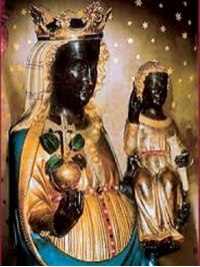Mary in Oropa

histories of the Sanctuary
With dominance, in the second century a.c. the Romans occupied the plains and the Gentiles "Liguri-Celts" are forced to retreat in the mountain valleys such as Oropa, carrying with them the worship of "Matronae or matters" honored as protective of the fields, nature and family.
Join us
From Saint Eusebius now
People gathered from sources, streams, woods, large rocks, considered the local presence of mattress, female deities.
Oropa, in fact, with its basin is a classic Celtic stone circle, where the "Barma", i.e. the cave ceiling is formed by a natural mentis. And in this cave formed by boulders and sacred to the Celtic matrons in the IV century AD St. Eusebius introduced the cult of Mary carrying a wooden statue of the black Madonna with the child in her arms, that the tradition carved by St. Luke.
Some time after Eusebius built further south and away from another "Barma" Sacello as the most convenient place to worship.
Pope Innocent III in the Bull of 1207, speaks of the Oratory of Saint Mary od Oropa "and St. Bartholomew in which some hermits, celebrating the divine office.
In 1294 the Bishop of Vercelli, Amine Challant of salt to Oropa to consecrate a second Church of Saint Mary "wider for the veneration of the Virgin and the devotion of the people. E 'standing before the Sacellum of Eusebius..
This requires the bishop in 1298, through his will, to celebrate a Mass at Oropa weekly in memory of St. Eusebius.
In 1536 is built around the altar of the Church called a corridor antis sacellum, then opens a window protected by a grating to allow devotees to the vision of the statue of the Madonna, even by the Church called "great".
At this time the Church of Saint Mary of Oropa becomes the subject of papal and bishops, until in 1459 came from Pope Pius II assigned with the land that belonged to the fees of Saint Stephen of Biella, who took and do not leave more care.
For the large turnout of pilgrims in 1600 the Bishop Stephen Ferrero had built a basilica which incorporates the old church, the Sacellum. Jobs that lasted until 1621.
In 1620 around the basilica started the construction of the fence dell'Arduzzi great.
In 1920 the anti scallop was demolished and is inserted in its place a low marble altar to enable the vision of the statue of the Virgin Mary, throughout the Basilica. The same was restored with the Sacello marbles as you can see today, it is contained in the Sacred Statue representing the Queen Mary with baby Jesus in her arms.
James Bears in 1488 he wrote: "ascending to the chapel of the Queen of Heaven, under the springs dell'Oropa, of which the first stone, the holy martyr of God Eusebio with his hands placed. In that place the Blessed Virgin shines for you great sanctity of wonderful miracles, not only by local people but also from far away you joins a crowd".
In the pastoral letter of 1595, Pope Clement VIII Oropa says: "... the ancient wooden image of the Blessed Virgin Mary, with whom fled St. Eusebius, while he was Bishop of Vercelli, fleeing persecution that Arians .. l 'other was held between the works of Saint Luke".
Subsequently, at different times and began the expansion works of the sanctuary, both urban and architectural. Participated in the "growth" of the Sanctuary as architects Philip Juvarra, Piero Beltramo, Guarino Guarini and others, to form a real city Marian.
In 1960, after two centuries of work projects and was consecrated the new basilica or Superior. Poate the first stone in 1885, work continued through two world wars. It has a dome that rises over 80 meters and can hold up three thousand faithful.
The coronations of the Holy Statue Oropa mark and add to the worship of Mary in her sanctuary:
- The first occurred in 1620 by the Bishop Goria with the participation of many of the faithful flocked from all sides.
- The second, a hundred years later, took place in 1720 by the Bishop Gattinara Bishop of Alexandria with the participation of several people.
- The third, also one hundred years later, took place in 1820 by the Cardinal Bishop of Novara Morozzo assisted by three other bishops. The crowd present was calculated in hundred thousand people.
- The fourth, also in the centennial, took place in 1920 by the papal delegate, Cardinal Theodore Valfrè of bonze, surrounded by all the bishops Piemontesi, Cardinal Richelmy, from San Giovanni Bosco. It was a crowd estimated at one hundred and fifty thousand people. In 1884 was laid the foundation stone of the new Basilica Monumentale that the magnificent art and the beauty of this sanctuary.
